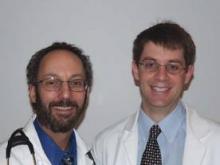Lung cancer is the leading cause of cancer mortality in the United States, killing over 160,000 people per year and accounting for 28% of all cancer deaths nationwide. The average 5-year survival is only about 15%, but when a lung cancer is diagnosed while still localized the 5-year survival increases to over 50%. Recently, the American Cancer Society (ACS) issued guidelines for lung cancer screening. These guidelines were based on three randomized trials, relying most heavily upon the findings of the National Cancer Institute’s National Lung Screening Trial (NLST), which was the largest of the three.
Screening candidates
The NLST enrolled over 53,000 high-risk people who were randomized to either annual low-dose computed tomography (LDCT) or chest x-ray for 3 years. Results showed that annual screening for 3 years with LDCT led to a statistically significant 20% decrease in lung cancer mortality. In addition, there was a 7% decline in all-cause mortality.
ACS guidelines recommend that clinicians initiate a discussion about LDCT lung cancer screening with individuals who meet the inclusion criteria for the NLST, including individuals 55-74 years of age who have at least a 30-pack-year history of smoking who are either current smokers or have quit within the last 15 years.
Before initiating lung cancer screening, the ACS guidelines propose a process of informed and shared decision making between clinician and patient to discuss the potential benefits, limits, and harms associated with LDCT lung cancer screening. Once initiated, annual screens should be continued until age 74 years. Patients with life-limiting comorbid conditions, metallic implants, or devices in the chest or back or those on home oxygen supplementation should not have LDCT screening.
Individuals, along with their providers, may decide against screening if they prefer to avoid testing that has a high rate of false-positive results and a small risk of complications as long as they understand and accept that lung cancer has a higher risk of death than do screening complications. The guidelines advise against discussing lung cancer screening with patients who do not meet NLST criteria, but the ACS notes that clinicians must use their judgment when deciding whether to discuss screening with a patient who does not strictly meet NLST eligibility criteria but appears to be at a similar or seemingly greater lung cancer risk than those meeting the criteria. Lung cancer screening should occur at an institution with an organized screening program, expertise in LDCT screening, and access to a multidisciplinary team skilled in the evaluation, diagnosis, and treatment of abnormal lung lesions.
Smoking cessation
An important corollary to the LDCT recommendations is that smoking cessation should continue to be emphasized and should remain a top priority in clinicians’ discussions with current smokers. Concerns have been raised that lung cancer screening may give a false sense of security to smokers and thereby lessen the strength of the physician’s smoking-cessation message. This does not appear to be the case. In fact, studies show that there is a higher rate of smoking cessation among those screened with LDCT than in unscreened groups. One might speculate that this simple fact of needing screening for a cancer makes the possibility of that cancer more real and increases motivation to stop smoking.
Risks and benefits
The ACS guidelines suggest key points of discussion between clinician and patient revolving around benefits, limitations, and harms of screening.
• Benefits: Screening with LDCT has been shown to reduce the risk of dying from lung cancer in properly selected high-risk populations, with a 20% decrease in lung cancer–specific mortality. In the NLST, the number needed to screen for 3 years to prevent one lung cancer death was 320.
• Limitations: LDCT will miss some lung cancers, will not detect some lung cancers early, and even with detection using LDCT may not necessarily prevent death.
• Harms: LDCT lung cancer screening results in a high rate of false-positive findings. Over three rounds of screenings, approximately 40% of screened individuals have a positive test. To decrease anxiety over the positive test, it is important for patients to understand this prior to being tested. Most of the positive tests require further imaging to risk-categorize the individuals, with a few individuals requiring invasive testing. Anxiety often accompanies additional testing. Less than 1 out of 1,000 patients with false-positive results experience major complications resulting from a diagnostic work-up.
The ACS points out that few government or private insurance programs cover initial LDCT for lung cancer screening. Since NLST evidence suggests that screening high-risk individuals can substantially reduce death rates from lung cancer, both private and public health care insurers should expand coverage to include the cost of annual LDCT screening for lung cancer in appropriate high-risk individuals.


